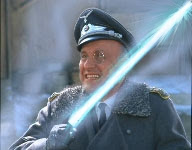After the disapointing results achieved by the flawed british Garratts, some viewers may approach the Australian types with caution. The truth could not be further, in a remarkable twist, the articulated beasts were among the finest steam locomotives to operate in our borders, and indeed, rank among the greatest in the Garratt class when viewed on a global scale. (It is another example of how different Australia is compared to britain as an environment for trains to operate in. There is no 'given gurantee' with any type- be it conventional or unusual- that means it will operate well anywhere since each line and environment is different. An example of a design that, the reverse from the garratts, did well in Britain but was a disaster in Australia is the Fairlie, of which I will comment further in a later issue)
The first state I will cover is South Australia. SA needed no broad or standard gauge garratts, mainly thanks to the 'big-engine' policy of Commissioner Webb. However, the freight locomotives on the narrow gauge line between Broken hill and Port Pirie (T-class 4-8-0s from 1909) were being decimated by the heavy and long ore trains. An order was placed with Beyer Peacock for 10 oil fired narrow gauge garratts. Unusually, the order was subcontracted on to a french company, Societe Franco Belge de Materiel de Chemins de fer. This resulted in a dsign with more of a french-belgian influence on the appearance, particularily regarding the nameplate and buffer design.
The imported garratts arrived in 1953 and displaced the disliked '300 class Australian Standard Garratts' bought as a stop gap from WA. The new type was a versatile and reliable design, often working express passenger trains in addition to the heavy ore loads.
Above: The South Australian Railways 400 class Beyer-Garratt
The types were finally displaced by the new diesel electrics in the late sixties and by january 1970 all had been withdrawn. Fourtunately, two survive, both unfourtunately as static exhibits.
Victoria, like South Australia, had just one indigenous Garratt type: the G Class narrow gauge garratt. These two locomotives were used on the lines out of Moe and Colac, replacing the Na Class tank engines which were under serious strain from double heading and increased loads. Like the other AUstralian Garratts, they were constructed at Beyer Peacock and began service in 1926.
The two garratts proved their worth over their predecessors with significant savings in fuel and water, and the elimination of double heading.The narrow gauge lines they worked on, however, closed in 1954 (Moe) and 1962(Colac). The first locomotive, number G41 was scrapped, but the second, G42, is in full working order on the Puffing Billy Railway.
G42 in working order on the Puffing Billy Railway.
Because of the difficulty in getting afew of the details of the other garratts (most especially WAGR garratts) I will have to split this article up and post the third part once its done.
Saturday, March 15, 2008
The Mighty Garratts part 2: Aussie Edition-section 1
Posted by Klink at Saturday, March 15, 2008
Subscribe to:
Post Comments (Atom)




0 comments:
Post a Comment